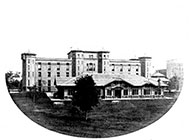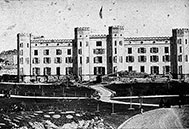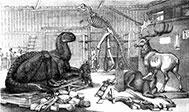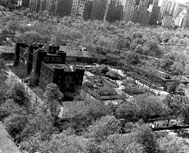History of the Arsenal
Find information about exhibits at the Arsenal Gallery at Arsenal Gallery webpage.
Welcome to the historic Arsenal Building! Located at 64th Street and Fifth Avenue in Central Park, the Arsenal is home to the New York City Department of Parks & Recreation, the Arsenal Gallery, the City Parks Foundation, and the New York Wildlife Conservation Society.
The Arsenal is one of two buildings within the park's borders which predate the park itself. It was built between 1847 and 1851 by the State of New York as a storage repository for munitions. The project's funding was overseen by state comptroller Millard Fillmore, who later became President of the United States.
Designed by architect Martin Thompson, the building is marked by a crenulated cornice, resembling a medieval fortress. Its doorway is guarded by a cast-iron eagle.
The building's military use proved short-lived. Between 1853 and 1856, the State seized the land under it for a public park. In 1857 the City purchased the Arsenal for $275,000, removed all arms, and established park administrative functions on the premises. Certain park advocates and urban observers felt the structure was a blight on the landscape, most notably diarist George Templeton Strong who in 1859 referred to the "hideous State Arsenal Building," and hoped "this eyesore…[would] soon be destroyed by accidental fire."
This was not to be, and over the ensuing decades the building served diverse roles. In 1857 the 11th police precinct was stationed here. The newly created American Museum of Natural History took up residence at the Arsenal from 1869 to 1877, before its current home was built on Central Park West. Exhibits were installed on the second and third floors. Also at this time, B. Waterhouse Hawkins, an eminent British paleontologist, spent time reconstructing the skeletal remains of dinosaurs in a special studio established at the Arsenal.
Beginning in 1859, a burgeoning menagerie was located in and around the Arsenal. Gifts or loans of animals by the likes of impresario P. T. Barnum, financier August Belmont and Civil War general William Tecumseh Sherman could be seen in outdoor cages and in the basement of the building. The "great insecurity and danger" of this arrangement, as well as the stench, resulted in the removal of the interior cages by 1871.
A Gallery of Art, later relocated to the former Convent of Mount St. Vincent at the park's north end, graced the first floor space. Prior to moving to the park's Belvedere Castle, the Municipal Weather Bureau's instruments were atop the Arsenal roof from 1869 to 1918.
Various designs for remodeling the Arsenal emerged over time. Jacob Wrey Mould, the Architect responsible for much of the ornamental detail at Bethesda Terrace and elsewhere in the park, remodeled the Arsenal interior in 1870. An Arsenal restaurant existed early in the 20th century. Also in 1916 the Parks Department considered demolishing the building altogether and relocating the weather bureau and police station to the Belvedere and Sheepfold (later Tavern on the Green) respectively.
From 1914 to 1924 the Manhattan Parks Department operated out of the newly built Municipal Building in Lower Manhattan and the Arsenal deteriorated to such an extent that in 1922 a headline in the New York Times read: “Parks Arsenal a Near Ruin.”
At that time the City appropriated $75,000 for an overhaul of the Arsenal. Most of the space was set aside for Parks Department offices. During reconstruction an underground spring and a secret passage were discovered (the latter possibly from the building’s days as an arsenal, for the undercover transfer of arms). The restoration was completed in 1924.
Having served off and on as the borough park offices, the Arsenal underwent another complete renovation in 1934 as the first and only headquarters of a citywide unified Parks Department. From his command posts at the Arsenal and at Randall’s Island, Commissioner Robert Moses set about directing an
unprecedented expansion of the parks system and the modernization of New York City’s public facilities.
In 1935-36 the Arsenal lobby murals were painted under the direction of Allen Saalburg. Saalburg depicted a series of scenes depicting recreational activities, notable park structures, and flagship parks. The project was funded by the Federal Works Progress Administration. Also at this time, a new entryway was designed for the front of the Arsenal, including military drums over the doorway and cast-iron musket replicas as supports for the banisters.
Over time the Arsenal has become a parks fixture. In 1967 the Arsenal was designated an official New York City Landmark. Two bronze eagles flanking the first floor entrance are original to the Prison Ship Martyrs Monument in Fort Greene Park, Brooklyn (replaced there by replicas in a 2008 restoration).
Since the early 1980s, the central chamber on the third floor of the building has been used as a gallery and space for public forums related to Parks’ mission and may be reserved for private and public functions. Six to eight exhibitions of fine arts and photography are mounted annually, and preference is given to shows concerned with the natural environment, urban issues and parks history.
Credits:
Jonathan Kuhn, Historian/Author
Matthew Fisher and Kate Milkens, Research Assistants
Kim Grant and Toby Allan, Layout
All photographs courtesy of New York City Parks Photo Archive
© December 2012 Fifth Edition




